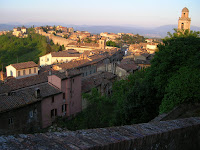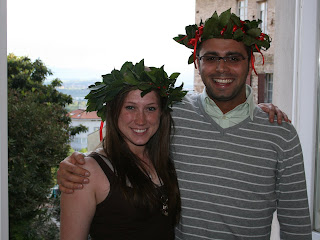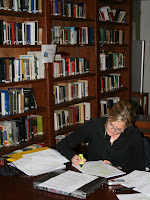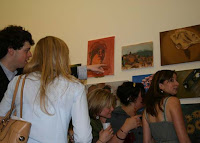Students in Professor Peter Fischer’s History and Culture of Food class were treated to a day at a Tuscan farm specializing in biodiversity. Students headed to the small Tuscan village of Montespertoli and spent time at the Poggio Antico farm. The community at Poggio Antico use a diversity of plants in order to balance each other out. They concentrate on the harmony between their crops, planets and sun signs and plant certain crops at certain times according to the sun and the stars. After a brief tour and introduction to the bio diverse farm, students were able to taste some of the products. A large spread of cheeses, yogurts and milk was easily finished quickly. The rest of the day was spent dining on a typical Tuscan meal.
Category: Umbra Blog
This blog documents the experiences of students currently studying at the Umbra Institute in Perugia, Italy, offering an account of their day-to-day experiences, extra- and co-curricular activities, and special events. We hope you gain some insight into what adventures Umbra students find outside the classroom during their semester in Perugia, a medieval town in the mountains of Umbria. Cheers!
 Perugia is renowned for its ability to preserve its cultural past. Indeed, when you walk its tiny alleyways, peruse its quaint shops and charming farmers’ markets, you can’t help but feel that time has slowed for this city upon a hill.
Perugia is renowned for its ability to preserve its cultural past. Indeed, when you walk its tiny alleyways, peruse its quaint shops and charming farmers’ markets, you can’t help but feel that time has slowed for this city upon a hill.
But aside from an aesthetic retention of its two millennia plus history, Perugia has also managed to hold onto a plethora of artesienal traditions, which only lend to the city’s sense of Italian authenticity.
As a part of the summer session’s Intensive Italian through Culture program, students are given a tour of these  artesienal workshops and crafts guilds, in order to become better acquainted with what their city has to offer.
artesienal workshops and crafts guilds, in order to become better acquainted with what their city has to offer.
This morning, students made their first stop just up the street from Umbra’s main academic building, on Via dei Priori, in a small ceramics shop known affectionately in Italian as “Il Pozzo delle Ceramiche Tattichi”. Students crowded into the small but neat and well kept shop, where they were given a demonstration on how exactly the artist-owner, Maria, plied her intricate trade.
And granted, while Maria didn’t have time to finish one of her Deruta-made ceramic pieces,  students nonetheless had ample opportunity to see the finished product. Nestled on shelves rested countless gorgeous works of art, all done of course by Maria in her shop.
students nonetheless had ample opportunity to see the finished product. Nestled on shelves rested countless gorgeous works of art, all done of course by Maria in her shop.
From there it was onto Perugia’s beloved “rilegatoria”, or book-binding shop, that sits slightly off of a creased tourist map. Here students were guided through the medieval process of bookbinding and leather making, and the “rilegatore” even showed students how to paint the leather bindings, made of goat skin.
The students then set off to the opposite side of Perugia to a hand woven fabric artisan. The Brozetti workshop  uses 18th century hand looms (the only in all of Italy who weave fabric by hand) to create beautiful and intricate tablecloths, centerpieces, tassels, etc, out of cotton, linen and even silk. The factory is housed in the church of San Francesco delle Donne and it is a truly magnificent place.
uses 18th century hand looms (the only in all of Italy who weave fabric by hand) to create beautiful and intricate tablecloths, centerpieces, tassels, etc, out of cotton, linen and even silk. The factory is housed in the church of San Francesco delle Donne and it is a truly magnificent place.
 Fortunately, as the students left the Brozetti workshop, some of the bad weather that had hounded the students since they started their journey earlier in the morning moseyed on down the valley, making way for a little bit of summer sun. And how befitting! The last stop of the trek, a chocolate workshop, required a healthy amount of rays, naturally! The shop, Augustia Perusia, is run by a true master of the cocoa bean. Students saw his various tasty wares, and even had the chance to sample some of the fine dark stock. It was a wonderful end to an eye-opening day!
Fortunately, as the students left the Brozetti workshop, some of the bad weather that had hounded the students since they started their journey earlier in the morning moseyed on down the valley, making way for a little bit of summer sun. And how befitting! The last stop of the trek, a chocolate workshop, required a healthy amount of rays, naturally! The shop, Augustia Perusia, is run by a true master of the cocoa bean. Students saw his various tasty wares, and even had the chance to sample some of the fine dark stock. It was a wonderful end to an eye-opening day!
 Last Friday Umbra students hopped on a bus bound for Orvieto, without a doubt one of Italy’s most striking cities. Perched on a butte of volcanic tuff and protected by towering vertical walls made from the same stone, the once major center of Etruscan civilization now plays host to one of the greatest examples of Gothic architecture in Europe. Touring Orvieto’s travertine and basalt striped Duomo, with its reaching and magnificent façade surely made for the most breathtaking moment of the day, although the views offered from Orvieto’s
Last Friday Umbra students hopped on a bus bound for Orvieto, without a doubt one of Italy’s most striking cities. Perched on a butte of volcanic tuff and protected by towering vertical walls made from the same stone, the once major center of Etruscan civilization now plays host to one of the greatest examples of Gothic architecture in Europe. Touring Orvieto’s travertine and basalt striped Duomo, with its reaching and magnificent façade surely made for the most breathtaking moment of the day, although the views offered from Orvieto’s looming battlements came in a close second.
Having taken a tour of the city’s historical center, it was off to the small and imminently charming village of Titignano, where students were treated first to a wine tasting, and then to a lunch boasting course after course of traditional Umbrian dishes, which included, among other things, pasta with a wild hare sauce and papardelle with a boar ragù. Contentedly full and certainly ready for a mid-afternoon nap, students boarded the bus and headed back to Perugia. What a day!
(in pictures: a panoramic view of Orvieto; Professor Giampiero Bevagna leads students on a tour of Orvieto, including it’s famous Gothic cathedral)
 Summer has finally started to creep through Perugia’s ancient and winding streets, but warm weather isn’t the only new addition to Italy’s “Green Heart”. On Friday, nearly 130 American students representing a host of states and schools touched down in Rome’s Fiumicino airport, eager to kick off a spectacular month and a half summer session at the Umbra Institute.
Summer has finally started to creep through Perugia’s ancient and winding streets, but warm weather isn’t the only new addition to Italy’s “Green Heart”. On Friday, nearly 130 American students representing a host of states and schools touched down in Rome’s Fiumicino airport, eager to kick off a spectacular month and a half summer session at the Umbra Institute.

Having moved into their apartments and completed orientation, students can now look forward to a whirlwind of activities and special academic events – whether it be an afternoon trip to a castle in the countryside, or a tour of Perugia’s various nooks and crannies – all designed to give students a truly immersive vision of Italy and the region of Umbria.
Check back soon for updates on how the summer’s going!


 There is a sad time we all must endure each semester – saying goodbye. The Spring 2008 semester has ended and students have returned home or traveled away from Perugia. A semester abroad does pass quickly, unfortunately, as students boarded buses for the Rome airport Saturday. Like the students, we are reflecting on a great semester of student achievements and journeys. Although a new session begins in a few weeks at the Umbra Institute, we will remember the students from Spring 2008 for a long time.
There is a sad time we all must endure each semester – saying goodbye. The Spring 2008 semester has ended and students have returned home or traveled away from Perugia. A semester abroad does pass quickly, unfortunately, as students boarded buses for the Rome airport Saturday. Like the students, we are reflecting on a great semester of student achievements and journeys. Although a new session begins in a few weeks at the Umbra Institute, we will remember the students from Spring 2008 for a long time.
Last week, Umbra staff members celebrated one of their colleagues, Mauro Renna, for obtaining his Laurea degree, the equivalent of an American Master’s degree. Tradition allows graduates to adorn laurel crowns as they walk through the streets receiving congratulatory messages from everyone. When Mauro then heard that Umbra student, Jen Beegle, had finished her last final of her senior year, he decided to share the celebrations. Jen will return to Elon University for her official graduation ceremonies this week, but began the celebrations in Perugia. Auguri!
 Most Umbra students will leave Perugia this weekend to return to their friends and family in the United States. Before they leave, however, they must complete final projects and take final exams. We found Whitney Lochridge, a student from Elon University, in the library reviewing her notes for today’s Roman Empire final exam.
Most Umbra students will leave Perugia this weekend to return to their friends and family in the United States. Before they leave, however, they must complete final projects and take final exams. We found Whitney Lochridge, a student from Elon University, in the library reviewing her notes for today’s Roman Empire final exam.
 The Loop Café describes itself as a “container for art experimentation” and last night was no exception. Though more than experiments, attendees of the twice-yearly reading of the literary anthology heard well-polished pieces. The literary anthology, a fusion of essays from the creative writing and photographs from the photography classes, is in press but students read from their final drafts on the Loop’s stage as the lights changed from cyan to magenta to yellow and back. Cynthia Clough, professor of creative writing, was pleased with the event and the readings. “It was the perfect ending to a semester of writing and rewriting,” she commented. The open-mic event, much like the end-of-semester art show, allows students the opportunity to reflect on a semester in Perugia and share these experiences.
The Loop Café describes itself as a “container for art experimentation” and last night was no exception. Though more than experiments, attendees of the twice-yearly reading of the literary anthology heard well-polished pieces. The literary anthology, a fusion of essays from the creative writing and photographs from the photography classes, is in press but students read from their final drafts on the Loop’s stage as the lights changed from cyan to magenta to yellow and back. Cynthia Clough, professor of creative writing, was pleased with the event and the readings. “It was the perfect ending to a semester of writing and rewriting,” she commented. The open-mic event, much like the end-of-semester art show, allows students the opportunity to reflect on a semester in Perugia and share these experiences.
Tuesday night was the end-of-semester art show, a chance for students to  exhibit a semester’s worth of paintings, drawings, and photographs to their fellow students, as well as professors and interested guests. The Via Danzetta art studio was crowded with Umbra students, professors, and interested guests hoping to review the artwork on display.
exhibit a semester’s worth of paintings, drawings, and photographs to their fellow students, as well as professors and interested guests. The Via Danzetta art studio was crowded with Umbra students, professors, and interested guests hoping to review the artwork on display.
The art show was part of the Umbra Institute’s week of special academic events. Beginning with the performance of Mario Pirovano and ending with the Festa d’Addio, the week is designed to allow students time to review for finals while reflecting on a semester at the Institute.
In photos: Andy Ward directs the attention to student work.

